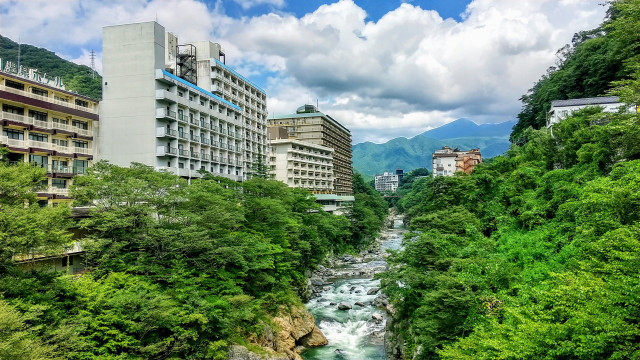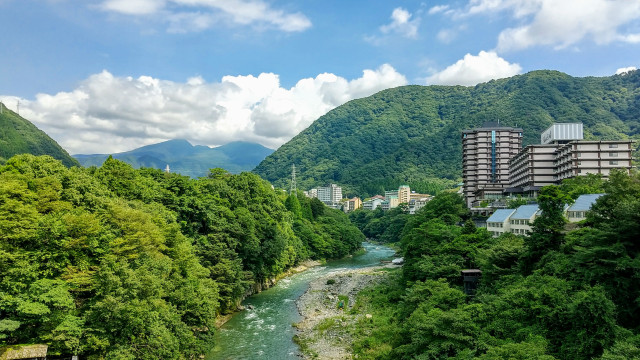Kinugawa Onsen: The Fearless Flow of the River
Historical and Cultural Significance

The Daimyo’s Retreat
Discovered in 1691 during the Edo period, Kinugawa Onsen was originally reserved for monks and daimyo (feudal lords) visiting Nikko. Originally called Taki Onsen, it was known for its healing properties for burns. The alkaline simple spring water is beneficial for neuralgia, shoulder pain, fatigue recovery, and overall health, making it enjoyable for a wide range of visitors.
Rough Flow of the River
The name "Kinugawa" has several origins, including “the rough flow of its river”, “Demon's Swamp” and historical silk washing practices. In the Meiji period, the hot spring opened to the public, evolving into a popular therapeutic and tourist destination as it developed into a major hot spring area along the Kinugawa Gorge.
Tourism flourished after the Shimo-no-Kaido (present-day Tobu Railway) opened in 1991, initially for transporting materials for a hydroelectric power plant and later for passengers. By 1927, newly discovered springs and increased hot spring inns led to the name "Kinugawa Onsen" encompassing both the east and west banks.
Kinugawa Onsen’s connection to Nikko
Kinugawa Onsen's rich history is intertwined with other key attractions in the Nikko area. Notably, Nikko Toshogu Shrine, dedicated to Tokugawa Ieyasu, features elaborate architecture and numerous national treasures. Additionally, Kegon Falls, discovered in the late 8th century, is renowned for its stunning 97-meter drop and seasonal beauty, making it one of Japan's top 100 waterfalls. These historical sites, alongside Kinugawa Onsen, highlight the area's cultural and natural significance, attracting visitors seeking both relaxation and historical exploration.
Who was Tokugawa Ieyasu?
Tokugawa Ieyasu (1543–1616) was a prominent Japanese military leader and the founder of the Tokugawa shogunate, which ruled Japan for over 250 years, marking the Edo period. Born into a turbulent era of warring states, Ieyasu emerged as a powerful daimyo, or feudal lord. He was instrumental in the unification of Japan, initially serving under Oda Nobunaga and later Toyotomi Hideyoshi, two other key figures in Japan's unification.
Following Hideyoshi's death, Ieyasu seized power after his decisive victory at the Battle of Sekigahara in 1600. This victory solidified his control over Japan and led to his appointment as shogun in 1603. As shogun, Ieyasu implemented a centralized feudal system that maintained stability and order throughout Japan. He established a rigid class structure, a policy of national seclusion, and promoted economic growth and cultural development.
Ieyasu's legacy includes the creation of a peaceful and prosperous era in Japanese history, with the Tokugawa shogunate maintaining relative peace until the Meiji Restoration in 1868. He is enshrined at the Nikko Toshogu Shrine, a UNESCO World Heritage site, reflecting his lasting influence on Japanese culture and history.

Hot Springs
Day Use
- Asaya: A historic inn with over 130 years of history. Famous for its rooftop open-air bath, Asaya Hotel offers a luxurious day-use experience with a large buffet featuring local seasonal ingredients.
- Kinugawa Onsen Hotel: Renowned for its hospitality and thematic "Yu Meguri", this hotel provides access to large communal baths made from wood and stone, perfect for a relaxing day trip.
- Kinugawa Onsen Monogusa no Yado Hanasenkyo: Guests can enjoy spectacular views of the Kinugawa River from the baths, which include a partially-open outdoor bath and a spacious indoor bath.
Other Notable Hotels and Hot Springs**
- Kinugawa Park Hotels Kisentei: Features various baths and a relaxing atmosphere.
- Hotel Sunshine Kinugawa: Known for its proximity to Kinuta Rock Suspension Bridge.
- Kinugawa Kanaya Hotel: Offers a blend of Japanese and Western styles.
- Hoshino Resorts Kai Kawaji: A riverside inn with rustic charm.
- Ishinkan: Known for its healing waters and picturesque views.
Attractions
Kinugawa Onsen is not only a place for relaxation but also offers a diverse range of activities and attractions that cater to different interests, making it an ideal destination for tourists.
Nature and Scenic Spots
- Kinugawa River Cruise: Enjoy a 40-minute boat trip, a famous activity in Kinugawa Onsen.
- Kinuta Rock Suspension Bridge: A pedestrian bridge linking the hot spring town and Kinuta Rock.
- Ryuo Gorge: A natural marvel with giant rocks and bizarre stone formations.
- Five-Color Waterfall: A hidden spot with a small, soothing waterfall.
- Rainbow Falls: A highlight of the Ryuo Gorge walk.
- Kawaji Dam: Enjoy views of the dam and surrounding nature.
- Shidarezakura at Kinugawa Park: Quiet cherry blossom viewing spot.
- Kawaji Onsen Square Walk Tour: Tour to visit power spots in Kawaji Onsen.
- Kinugawa Park Sheer Cherry Blossoms: Serene spot for cherry blossom viewing.
Theme Parks and Family Attractions
- Edo Wonderland Nikko Edomura: Experience the Edo period through various activities and performances.
- Tobu World Square: Travel the world by viewing detailed replicas of famous structures.
- 3D Maze Dinosaur Hall: A dinosaur-themed maze park.
- Nikko Strawberry Park: Pick and enjoy fresh strawberries.
- Edelweiss Ski Resort: A family-friendly ski resort.
- Hunter Mountain Shiobara: A large snow resort in the highlands.
Cultural and Historical Sites
- Nikko Edo Village: Recreated Edo-period town for immersive experiences.
- Kinugawa Shrine's Someiyoshino: Famous for beautiful cherry blossoms and night illumination.
- Kinugawa Onsen's Seven Lucky Gods Stamp Rally: Collect stamps around the hot spring town.
- Kinugawa Gorge Shrine: Known for its historical and cultural significance.
- Nikko Toshogu Shrine: A World Heritage Site: Nikko Toshogu Shrine in Nikko City enshrines Tokugawa Ieyasu, the first shogun of the Edo period. It is the main Toshogu shrine in Japan, known for its elaborate architecture and numerous national treasures and important cultural properties.
- Kegon Falls: Selected as One of Japan's Top 100 Waterfalls: Kegon Falls, discovered in the late 8th century by Shodo Shonin, is a breathtaking 97-meter-high waterfall named after the Kegon Sutra. It offers stunning views year-round, including vibrant green foliage in May and ice formations in winter.
Recreational Activities
- Fishing at Ohara Stream: Experience catching river fish.
- Cycling at Kinugawa Road Station: Enjoy cycling routes along the scenic roads.
- NAOC Nikko Base: Outdoor adventure guide services.
- Grande Isola Circuit: A racing circuit for time trials.

Access
To access Kinugawa Onsen from Tokyo, you have several options:
By Train:
-
From Tokyo Station or Ueno Station:
- Take the JR Tohoku Shinkansen (Yamabiko, Nasuno, or Hayabusa) to Utsunomiya Station.
- Transfer to the JR Nikko Line and take a local train to Shimo-Imaichi Station.
- From Shimo-Imaichi, transfer to the Tobu Kinugawa Line and take a local train to Kinugawa-Onsen Station.
-
Direct Tobu Limited Express:
- From Asakusa Station, take the Tobu Limited Express "Kinu" or "Revaty Kinu" directly to Kinugawa-Onsen Station. This is a direct train service, and the journey takes approximately 2 hours.
By Car:
- You can drive from Tokyo to Kinugawa Onsen. It takes about 2-3 hours depending on traffic. The most common route is via the Tohoku Expressway and National Route 121.
By Bus:
- There are also direct highway buses available from various points in Tokyo, including Shinjuku Station and Tokyo Station. The journey by bus usually takes around 3-4 hours.
Each of these methods offers a different experience and time efficiency, so you can choose the one that best suits your travel preferences.
find your next getaway
Kumamoto
2 adults